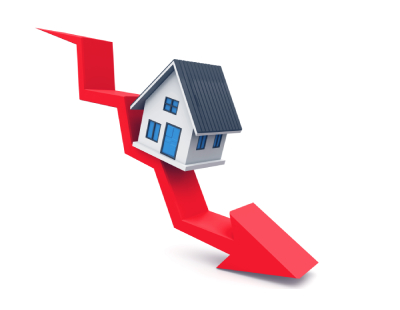More than 70 local authority areas have seen average house prices rise over the last year, bucking the national trend, Halifax says.
The analysis – based on Halifax’s own house price index – looked at typical property prices in more than 300 local authority areas across Britian in the three months up to September this year, and compared them to the equivalent figures from 2022.
While average prices are down nationally and across each region over the period by 3.9%, this masks some big variations in house price performance at a local level across the country.
A number of local locations have actually posted strong double-digit growth in property prices during the period.
Top of the list is Powys in Wales, with annual house price growth of 17.4% in the 12 month period to £253,958 – a £37,651 increase.
Next is East Lindsey on the east coast of Lincolnshire, which saw average prices rise 13.3% to £220,421 – up £25,888.
Moray in Scotland makes up the top three with 10.7% growth and a £17,347 increase in prices to £179,606.
Kim Kinnaird, director of Halifax Mortgages, said: “There are multiple factors which can impact house prices in your local area, ranging from the mix of properties available and the extent of any new housing, to the quality of schools and abundance of job opportunities.
“What’s clear is that the UK housing market is not a single-entity that performs in a uniform way across the country, there are differences. While at a national level the current squeeze on mortgage affordability has seen property prices fall over the last year, in many regions there remain pockets of house price growth. While a limited supply of properties for sale could be a factor, this also suggests in some areas, local market activity – and demand among buyers – remains strong.
“Many of the places highlighted in our research also benefit from more remote or rural surroundings and incorporate areas of outstanding natural beauty. These are traits which continue to be desirable for prospective homeowners, bucking the trend of the wider performance of the housing market.”
Commenting on the research, Tom Bill, head of UK residential research at Knight Frank, said: “The UK is made up of tens of thousands of individual housing markets, which means price growth can also diverge between two areas in the same local authority.
“Broadly speaking, more affordable parts of the country are gradually closing the gap with London, where affordability is at its most stretched. The gap will get narrower without closing as buyers look beyond the capital for better value.
“The more important point for anyone interpreting house prices at the moment, is that fewer transactions can distort the data. The underlying health of the housing market is not necessarily gauged by what is happening to house prices but rather transaction volumes, which are down by more than a fifth.”
|
Local authority area
|
Nation/region
|
House price Q3 2022
|
House price Q3 2023
|
Annual % change
|
Annual £
change
|
|
Powys
|
Wales
|
£216,307
|
£253,958
|
+17.4%
|
£37,651
|
|
East Lindsey
|
East Midlands
|
£194,533
|
£220,421
|
+13.3%
|
£25,888
|
|
Moray
|
Scotland
|
£162,258
|
£179,606
|
+10.7%
|
£17,347
|
|
Babergh
|
Eastern England
|
£317,383
|
£349,965
|
+10.3%
|
£32,583
|
|
Sunderland
|
North East
|
£138,579
|
£150,862
|
+8.9%
|
£12,283
|
|
Ealing
|
London
|
£494,100
|
£531,127
|
+7.5%
|
£37,027
|
|
Westminster / City of London
|
London
|
£714,242
|
£767,350
|
+7.4%
|
£53,108
|
|
Bolsover
|
East Midlands
|
£167,398
|
£179,453
|
+7.2%
|
£12,054
|
|
Cumberland
|
North West
|
£165,346
|
£176,470
|
+6.7%
|
£11,124
|
|
Rossendale
|
North West
|
£185,658
|
£198,102
|
+6.7%
|
£12,444
|
















.png)


.png)




Join the conversation
Be the first to comment (please use the comment box below)
Please login to comment